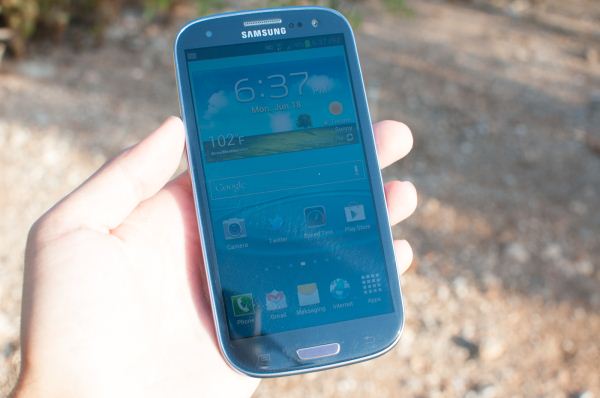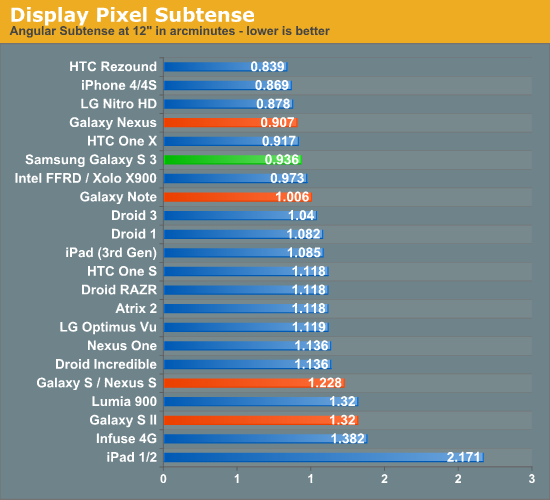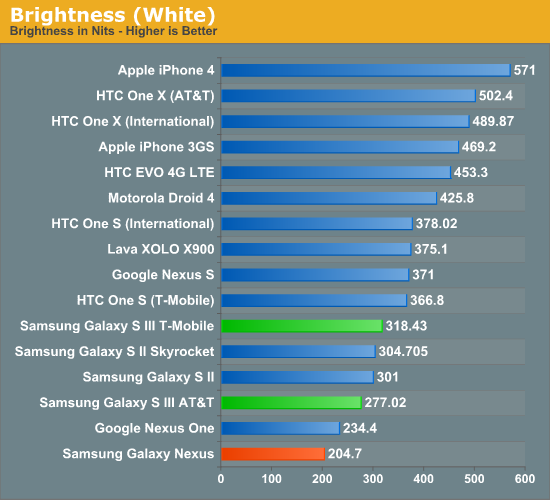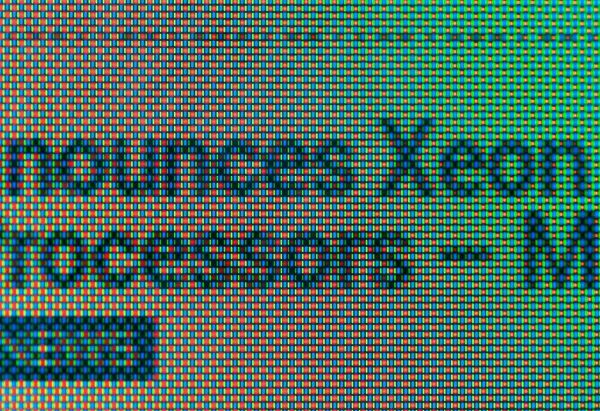Samsung Galaxy S III Review - AT&T and T-Mobile USA Variants
by Brian Klug on June 20, 2012 12:01 AM ESTOne of the standout features on the SGS3 is the 4.8" HD SAMOLED display, which has an effective resolution of 1280x720. Like other Samsung devices, the name tells you almost everything you need to know: HD connotes 720p, S for Super means the stack is optically bonded with fewer air gaps (and thus fewer fresnel 4% back reflections), and the lack of Plus means it’s an RGBG PenTIle subpixel matrix.
First off, it’s clear to me that the SGS3 display is a substantial improvement on the Galaxy Nexus display, which was 4.65" diagonal and also 720p HD SAMOLED. The problems that I talked about in the Galaxy Nexus display are basically completely absent in the SGS3. There’s no longer any mura (luminance variance which looks like noise) or a weird purple cast in the greys, two things that are still present on the Galaxy Nexus. I suspect that moving to a larger display with the same resolution (and thus larger subpixels) might have helped mitigate some of the mura, and in addition this appears to be a completely new revision of the process with none of those problems.

Outdoor viewing angles are pretty darn good
I think it’s also worth discussing PenTile once more - specifically in the context of whether or not you can see the pixels. At this point, I don’t think we need to go over what it is in much detail, but that it uses two sets of two subpixel units to achieve higher effective resolution than an RGB stripe. There are two variants - RG, BW which I’ve seen in a few Motorola LCD displays (that are Samsung), and RG, BG, which is the more common variant that is in all the AMOLED panels without the “plus” suffix.
The implementations that I complained loudest about were really the Nexus One and Nexus S / Galaxy S, where AMOLED was still somewhat in its infancy, and RG, BG was both a way to increase subpixel lifetime before fading took place (according to Samsung), and achieve a higher logical resolution with fewer subpixels than an RGB stripe would require. For that reason, you can’t really just evaluate a display with some boolean is garbage / not garbage based on the presence of PenTile alone. In theory, if the logical two-pixel cell is itself smaller than human visual acuity, then you shouldn’t be able to see it, and seeing the pixels is what drove me crazy about those two phones.
I present the following graph, which has the angular subtense in arcminutes along the stripe (when a device is held portrait, this is the x direction) of one logical pixel. That is to say, two subpixels if we’re talking about an RGBG PenTIle display, or three for an RGB display. For reference, human visual acuity is most often cited as being around 1 arcminute for the human vision system corrected to 20/20, which isn’t perfect vision (20/15 or slightly better is). Anything below that should be indistinguishable at a distance of 12 inches (standard viewing distance).

This is what I’m talking about when I say that in implementations such as the SGS3, even though PenTile is present, the logical pixel is still smaller than visual acuity, and the subpixels are half that. There’s still a case to be made for whether you can see fringing on black text on a white background to some extent, but personally I cannot see it.
So how is the display in other terms, such as brightness, color rendering, and viewing angles? For this I turned to the combination of my display colorimeter (still an i1D2), ColorHCFR, and Francois’s excellent Voodoo Screen Test Patterns.
When it comes to brightness, I found that oddly enough the T-Mobile and AT&T devices differed by a measurable and repeatable margin. Possibly these are from completely different batches, possibly there is some optimization done for the display brightness dynamic range to conserve battery - I’m not sure. Either way, it’s there, but the SGS3 is thankfully brighter than the Galaxy Nexus, though it still seems to be clamped to a fairly conservative number.

I measured blacks a few times and tried to see if I could get a reading on whether the SGS3 also has a slight DC bias (not fully off), but still couldn’t get anything. If it’s there, I haven’t noticed it yet.
In the Color HCFR testing, we can see that gamma looks very weird and nonlinear across the greys, going from around 2.4 down to 1.2, I have no idea what’s going on here. Color temp is thankfully a bit more controlled, at just under 7000K, and relatively flat.

I measured both devices after seeing that there was variance, and uploaded the color.chc files for both the AT&T and T-Mobile model for people with HCFR installed to check out. I’ve also made two galleries for the respective panels. I’ve heard really good things about the International SGS3 from Francois (supercurio), but haven’t measured it yet. I guess these initial numbers make me suspect that like SGS2 the USA variants have differences in the display rendering. I will say that over a range of brightnesses the SGS3 seems to have much less of the color shift compared to other AMOLEDs I’ve seen in the past.























107 Comments
View All Comments
dijimoto - Wednesday, June 20, 2012 - link
I just realized it was in the title ICS version 4.0.4, ugh...EJ257 - Wednesday, June 20, 2012 - link
So does it use both GPS & GLONASS simultaneously? Or can you set a default and it'll switch over to the other system whenever signal from one of them gets to be too weak?Death666Angel - Wednesday, June 20, 2012 - link
I enjoyed it a lot. I like the fact that 1080p video isn't cropped anymore. My cropped SGS2 1080p doesn't look that good and I use 720p as a result.The screen looks good too and mostly I think the SGS3 looks pretty good. But for me, it's not enough to make the upgrade from my SGS2. I just bought a nice chinese tablet (Cube U30GT if anyone wonders) which will keep me happy for some time to come. I won't upgrade this generation. WVGA resolution, SAMOLED+, Mali GPU and good custom ROM support are all enough for me, for now. Maybe next year Intel will bring something new or Android 5/6 will change things. But right now, my SGS2 does everything I need it to do.
Maybe I didn't notice it, but I didn't see any references to bootloader/custom ROMs. For me, whether or not a phone is easily rooted, hacked etc. is an important part of my purchase decision. Maybe you can include a short discussion of that in the future? If you did mention it, I apologize. :-)
chiza69 - Wednesday, June 20, 2012 - link
I usually love your reviews Brian as they are often unique and give a different perspective compared to other tech sites. However, one thing that frustrates me, and is consistent in all your reviews is the performance category.All you do in this category is run benchmarks. Yes, benchmarks are always fun, but both the iPhone and most Windows Phones have proven that benchmarks do not make a system run smoothly. I mean look at the latest android phone, the Galaxy S3, with it's quadcore processor and top of the line GPU. Yes it is fast in benchmarks, but honestly it still cannot make Android as smooth as iOS.
All I would like to see is that you add a video of typical performance on the phone, especially with the browser.
name99 - Thursday, June 21, 2012 - link
"Clearly there is 380 MB absorbed for both preallocated GPU memory, and possibly DRM / baseband, and after that subtraction the only way to get dual channel (2x32b) LPDDR2 is to make the jump to two 1 GB LPDDR2 devices."I don't get this. Why can't you have a 1GiB and a 512MiB package? Are ARM memory controllers less sophisticated than Intel ones and unable to handle such a config? After all this sort of config is standard on Windows --- 3GiB back in the day when that was all Windows could handle, now 6GiB on your mid-range laptops that are too cheap to spring for 8GiB.
antony22 - Thursday, June 21, 2012 - link
well been waiting for some reviews of the GS3 I was going to get this or the EVO 4G lte on sprint but after a read the whole article I think I made my choice nowI cant believe that Samsung chose not to use the on board Wi-Fi and went with another chip when the on board is 28 nm while the BCM4334 is 45nm
when i was reading the battery life test I thought hmm that is odd that the HTC EVO has better life on wi- fi than the GS3 even when they use the same SOC now everything makes sense and also the GS3 is slower too on wi-fi
SanX - Thursday, June 21, 2012 - link
Brian,In the section about display pixel angular dimensions (0.933 arcmin) you have used word "pixel" while it is actually just the green subpixel angular size. BUT THAT IS WRONG! The largest problem is the red subpixels angular distance (and contrary to laws of physics much less blue). This gives dirty feel of solid colors of red part of spectrum and jagg of lines. THAT IS EXACTLY the main problem of the pentile displays. And that's red and blue distance TWO time larger the green one and of course IS visible very well - just place the screen of LG Nitro nearby.
Another problem is your 12 inch distance. Formally and practically the the optimal distance for reading is usually 10 inch (25 cm). This is also why in magnification of lens in physics 25cm is used. I typically take phone even closer - to 9". You barely stand pentile screens in this case.
We always forget, but ideally for proper scaling of small fonts, because we have digital, not analog screens, it's not a one pixel angular size must be unresolved by our eyes but around TWO stacked ones. That gives 600ppi requirement. Only after that we will not see visible difference (jumps) in line thickness when scale fonts.
Belard - Thursday, June 21, 2012 - link
So... with these current "smart" phones... do anyone of them have good enough speakers to actually wake a person up?That would be a NICE little added benchmark. How loud can the phone get.
I'm about to retire my SGS1... its speakerphone mode has always been garbage (being that it faced away from you) and the alarm itself has been pathetic. So bad, that I still us a 4 year old Sony dumb phone as wakeup alarm. Even when this stupid phone "rings", I miss half the calls because the speaker and its vibration are weak.
How about this... make phones that actually FEEL good in the hand, not some danty tablet-size thingy that you can barely hold onto with your finger tips that doesn't FIT in a pocket. Sure, its fine for those who wear a purse and it seems some guys are wearing purses or bags... that's fine.
But many of us guys put the phones in OUR pockets where there is money, wallets, keys and whatever.
The SGS1 was already too damn big to comfortly fit into a pocket... the S3 and now bigger S3 should just make it much worse.
Eridanus - Thursday, June 21, 2012 - link
SD card slot? So they screwed up only customers of their Nexus crap?apoorvnaik - Thursday, June 21, 2012 - link
As seen in your post, you say that a T-Mobile SGS3 will work on AT&T's network also but the specs on the T-Mobile's page say something else.Here's the link to the T-Mobile page
http://www.t-mobile.com/shop/Phones/cell-phone-det...
I'm looking forward to buy this phone and just wanted to make sure that it could be used worldwide.